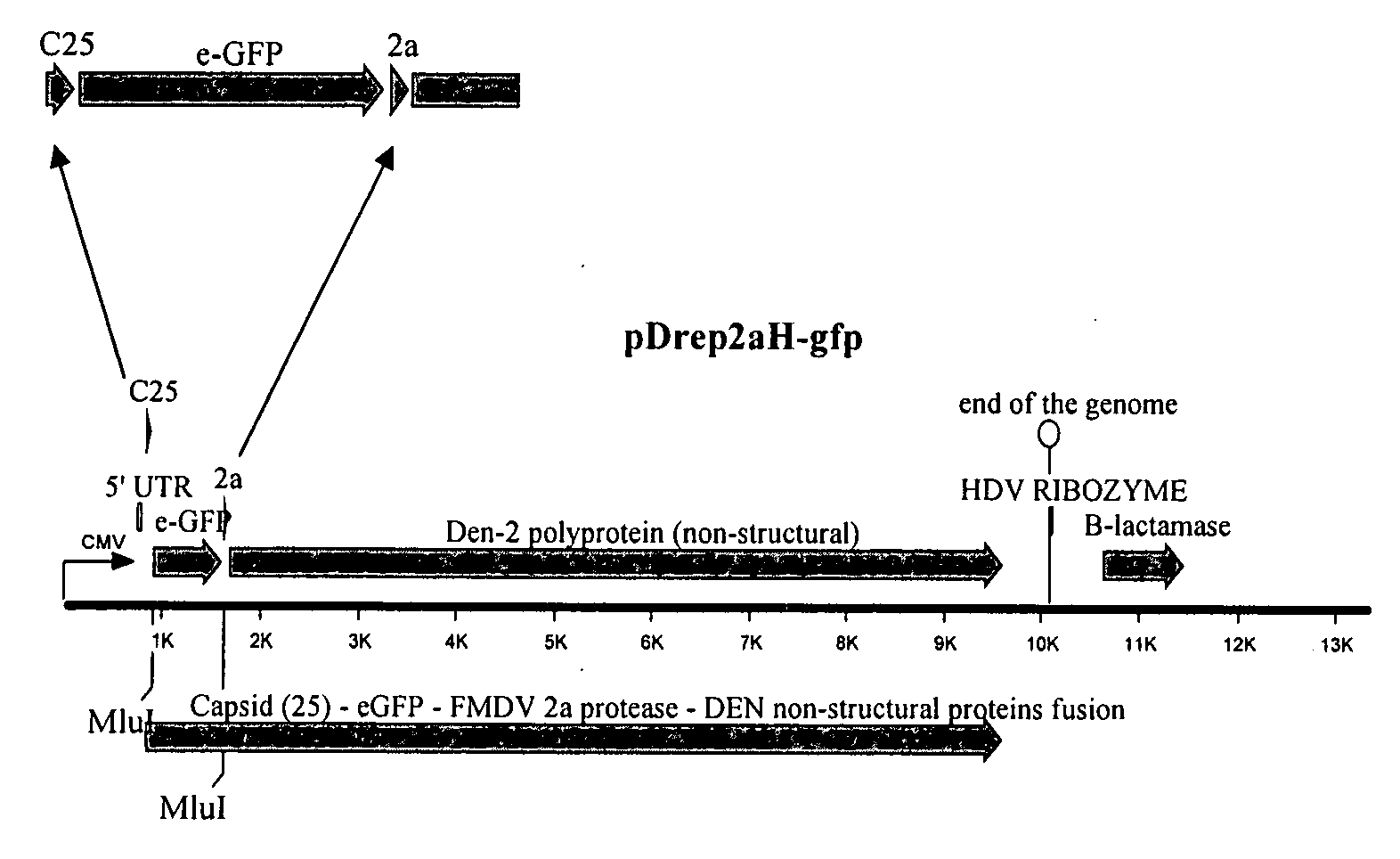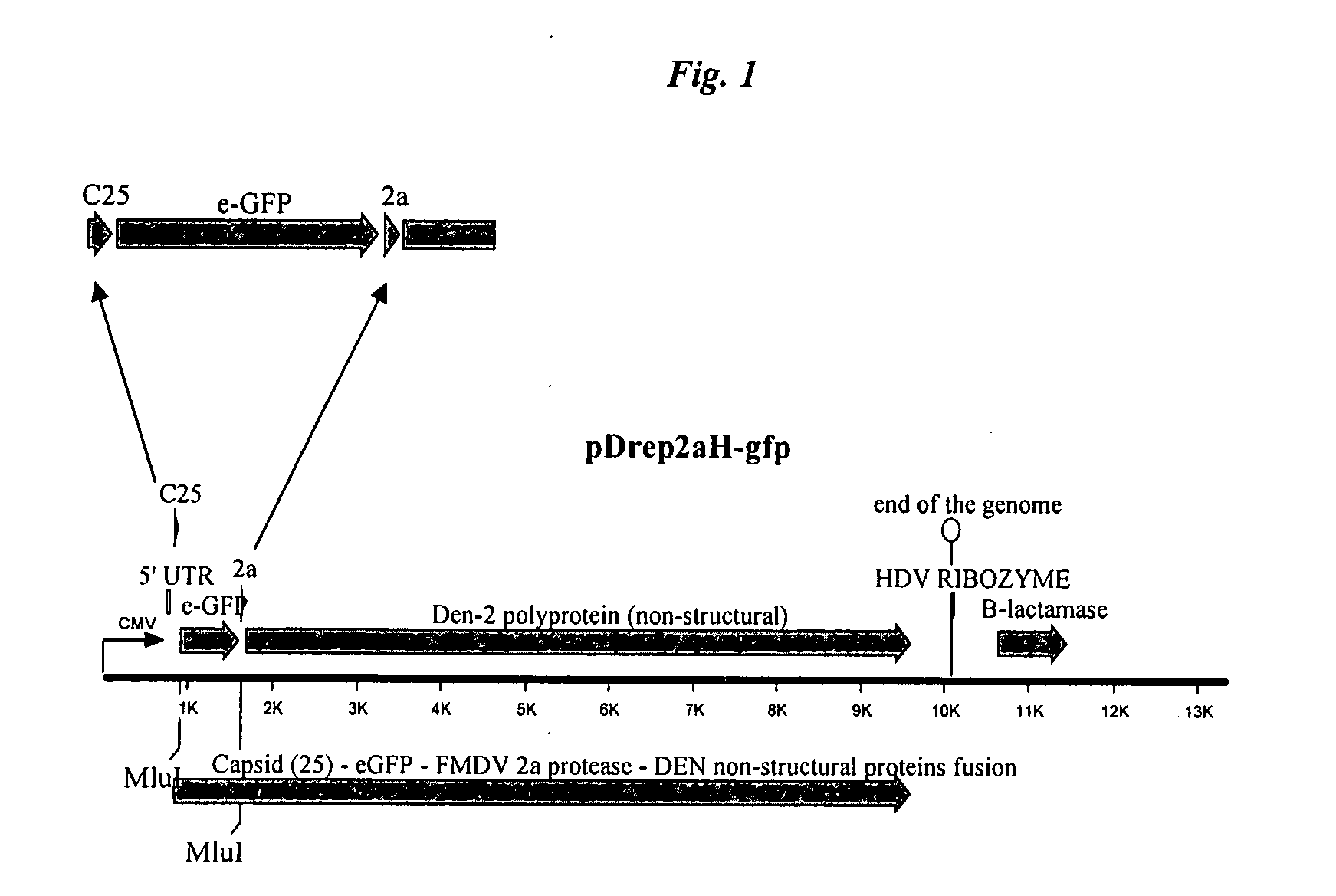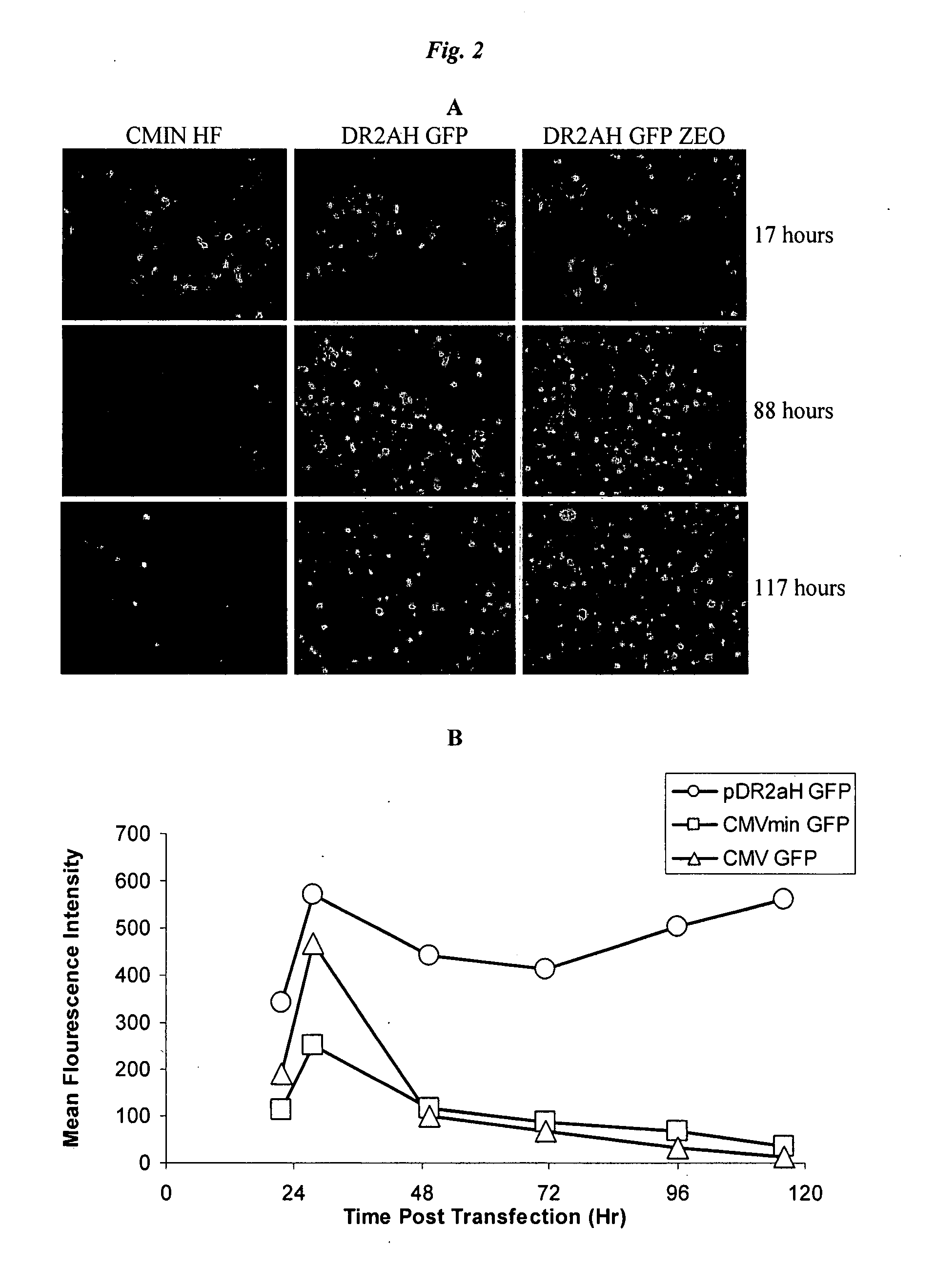Dengue Reporter Virus and Methods of Making and Using the Same
a reporter virus and dengue technology, applied in the field of dengue reporter virus, can solve the problems of limiting the quantitative power of plaque assay, the presence of den antibodies has also been linked to a more severe clinical outcome, and the difficulty in vaccinating den antibodies
- Summary
- Abstract
- Description
- Claims
- Application Information
AI Technical Summary
Benefits of technology
Problems solved by technology
Method used
Image
Examples
example 1
Construction of a Monocystronic DNA-Launched Dengue Subgenomic Replicon
[0084]We used a partially constructed Dengue 2 monocystronic replicon plasmid (pDENRep mono 1) as a starting material for constructing a vector useful for RVP replicon production (Holden, et al. (2006), Virology, 344:439-52). This plasmid contained the DEN2 strain 16681 genomic sequence, modified by replacement of a portion of the structural gene sequences with the firefly luciferase gene. Further modification of this plasmid is summarized in FIG. 1.
[0085](i) This vector was first modified by addition of the CMV promoter and FMDV 2a protease using overlapping PCR technology. A fragment of pWrep2aH-(Mlu) (Pierson, et al. (2005), Virology) was amplified with primers WDI (TTTTTTCCAAAGCTATGGTCAATATTGGCCATTAGCCATATTATT) (SEQ ID NO:1) and WD2 (GCTGCGTGAATTCATTCCTATAGGACCAGGGTTACTTTCAAC) (SEQ ID NO:2) using Invitrogen's Platinum Pfx polymerase under the manufacturer's recommended conditions. This fragment carries the CM...
example 2
Construction of a Plasmid that Expresses DEN Structural Proteins
[0092]Molecular clones for the WestPac Dengue 1, and PDK50, New Guinea C, and 16681 Dengue 2 strains were obtained. These constructs were used as templates for amplification of the capsid, premembrane protein, and envelope structural gene regions. Primers used for the reactions are listed in Table 2 below:
TABLE 2Primers used to construct Sequence #1PrimerNamePrimer Sequenced 1caccATGAATAACCAACGGAAAAAGGCGA(SEQ ID NO: 20)d 2TTTCACTATTAGGCCTGCACCATGACTCCCAAATAC(SEQ ID NO: 21)d 3caccATGAACAACCAACGGAAAAAGACGGGT(SEQ ID NO: 22)d 4TTTCACTATTACGCCTGAACCATGACTCCTAGGTAC(SEQ ID NO: 23)DR2AAGTTACGCGTGGACACGCGGTTTCTCTCGCG(SEQ ID NO: 6)DREP1GAAGCCCTAGGATTCTTAAATGAAGAT(SEQ ID NO: 7)DREP4TTATCATCGATTACCACATTTGTAGAGGTTTTACTTGC(SEQ ID NO: 10)WD1TTTTTTCCAAAGCTATGGTCAATATTGGCCATTAGCCATATTATT(SEQ ID NO: 1)WD2GCTGCGTGAATTCATTCCTATAGGACCAGGGTTACTTTCAAC(SEQ ID NO: 2)DREP2GCTGCGTGAATTCATTCCTATAGGACCAGGGTTACTTTCAAC(SEQ ID NO: 8)DREP3TGCTGTTGAATCA...
example 3
Construction of Cell Lines for Producing DEN Reporter Virus and SVPs
[0095]Cell lines were generated using the Invitrogen T-REx 293 cell line. Cells were plated in 6 well dishes at one million cells per well in complete medium. Plasmids containing DEN structural proteins (prME) from different strains, as described herein, were used. Plasmids were transfected using Lipofectamine 2000 as recommended by the manufacturer. 48 hours post-transfection, cells were trypsinized and plated in T75 flasks with complete DMEM, supplemented with 500 μg / ml G418 and 10 μg / ml blasticidin. Cells were cultured for three weeks in selective media with trypsinization and reseeding as needed upon reaching near confluence. Pooled selected cells were aliquotted and frozen in FCS, 10% DMSO freezing medium and placed in liquid nitrogen storage. Cells were split into 6 well dishes and cultured in the presence or absence of 1 μg / ml doxycycline. Cells were lysed with PBS, 0.5% Triton X-100, and soluble lysate exami...
PUM
| Property | Measurement | Unit |
|---|---|---|
| Fraction | aaaaa | aaaaa |
| Fraction | aaaaa | aaaaa |
| Time | aaaaa | aaaaa |
Abstract
Description
Claims
Application Information
 Login to View More
Login to View More - R&D
- Intellectual Property
- Life Sciences
- Materials
- Tech Scout
- Unparalleled Data Quality
- Higher Quality Content
- 60% Fewer Hallucinations
Browse by: Latest US Patents, China's latest patents, Technical Efficacy Thesaurus, Application Domain, Technology Topic, Popular Technical Reports.
© 2025 PatSnap. All rights reserved.Legal|Privacy policy|Modern Slavery Act Transparency Statement|Sitemap|About US| Contact US: help@patsnap.com



